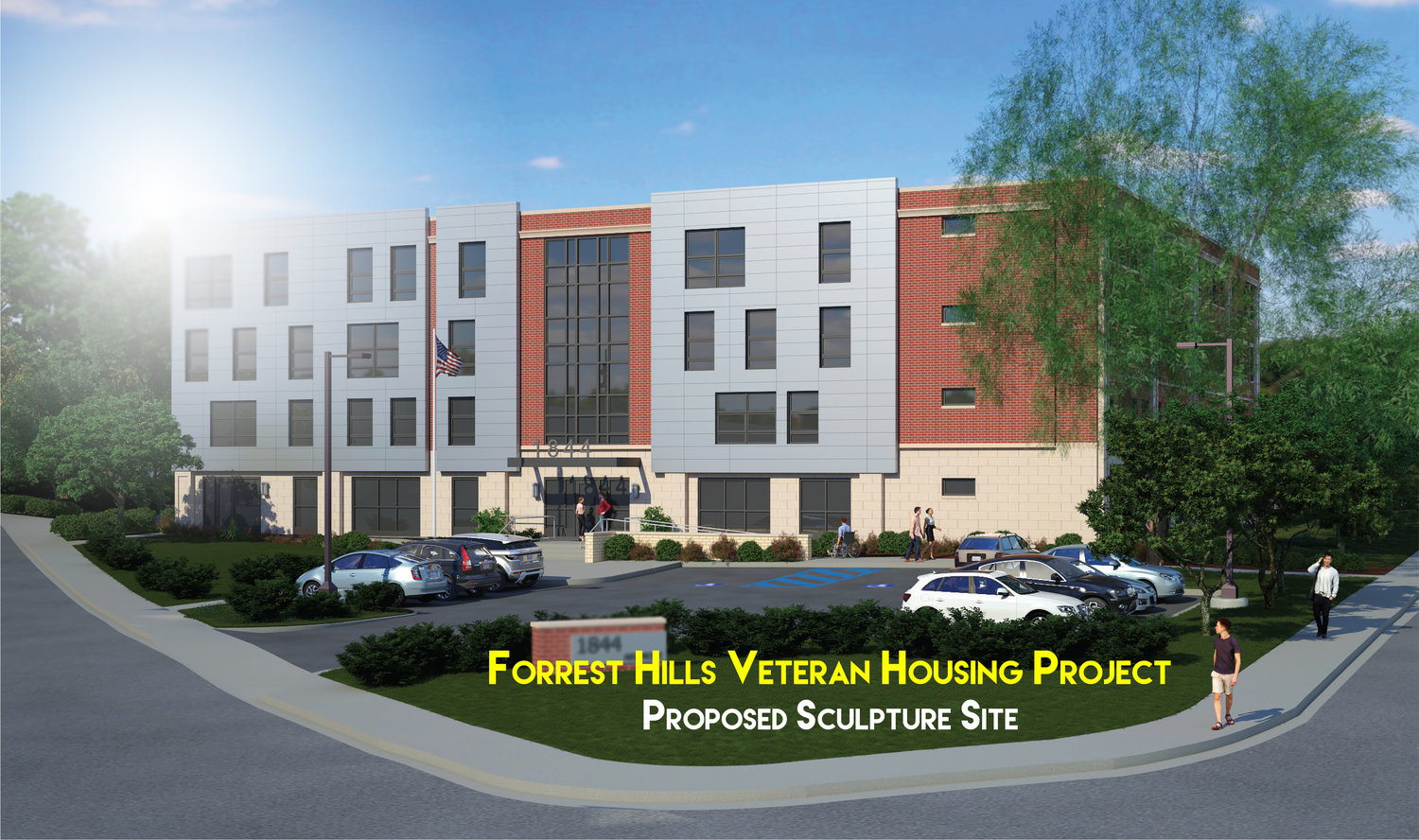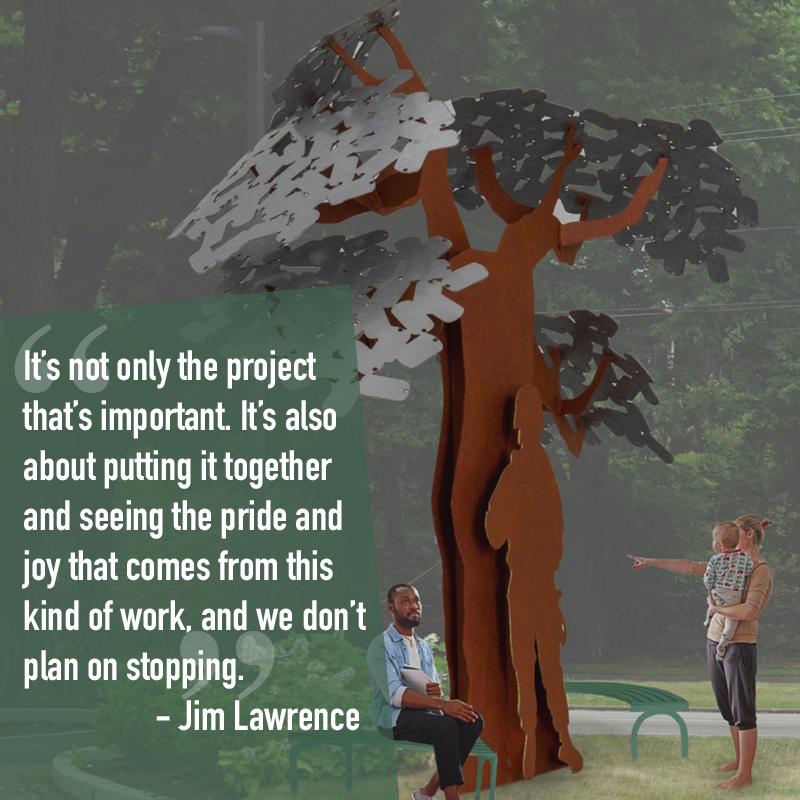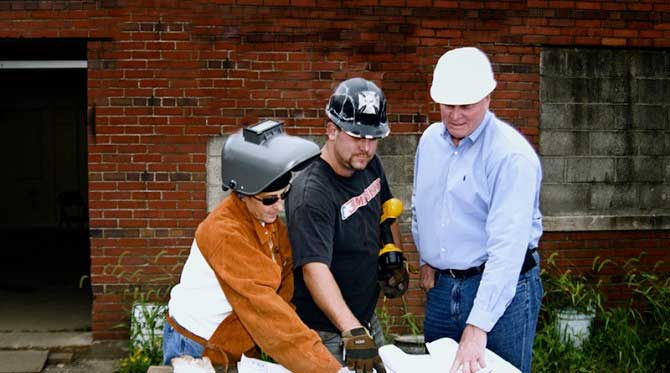When Randy Castriota, president of Castriota Metals & Recycling in Pittsburgh, Pa., spoke to Century Club members at ISRI2022 about the latest sculpture project he’s working on with the nonprofit Operation Valor Arts (OVArts), a nonprofit Veterans’ organization, he had no idea that a donation would come from a fellow ISRI member across the country.
The sculpture, In the Shade of Service, is scheduled to break ground in May. The 18-foot stainless and Corten steel sculpture will be installed at Forest Hills Veteran Housing in Forest Hills, Pa. The sculpture was designed by a team of Veterans assembled by Operation Valor Arts after the property owner, ACTION-Housing, commissioned the project.
David Bernstein, co-owner of Sioux City Compressed Steel and State Steel Supply Co. in Sioux City, Iowa, attended the Century Club meeting in March with his uncle Norman Bernstein who just turned 89. David Bernstein had never met Castriota before—but when he heard Castriota asking for donations of Corten steel he was happy to volunteer.
“We have access to a lot of Corten steel, so I tossed it out there,” Bernstein recalls. “We connected with Randy about donating the steel and we also offered to laser cut it, whatever they need we’re happy to do it, it’s a beautiful project.”
Castriota says when he told Bernstein the steel would have to be shipped nearly 1,000 miles east, “He said, ‘Just send me the drawings.’ So, he’ll donate the Corten steel, cut it with a laser cutter, and ship it to Pittsburgh.”

Processing Veterans’ Experiences
Castriota co-founded OVArts with artist Allyson Holtz to provide Veterans with education, training, and resources to create interpretive public art to process their experience of war; engage with fellow service members to accomplish new missions at home; connect with opportunities in art, design, and technology fields; and honor fallen service members and their families.
“In the Shade of Service started with a group of veterans from a networking organization called Leadership Pittsburgh,” says Holtz, OVArts’ executive director. “The group connected with our partner, ACTION-Housing, a long-established Pittsburgh organization that rehabilitates buildings for Veterans and seniors.” Later, ACTION-Housing approached OVArts about assembling a team of Veterans to create a piece of public art.
The organization does not require Veteran volunteers to have a background in art, so each Team is guided by a professional sculptor or lead artist. “The professional artist uses aspects of Human Centered Design to bring out ideas and responses and help Veterans realize their ideas,” Holtz explains.
OVArts welcomes Veterans, spouses, and Gold Star family members. Early in the process of a project, the lead artist provides initial training for volunteers in 3D design. Volunteers also learn about various types of interpretive contemporary public art projects.
“We do not build memorials,” Holtz says. “These pieces are interpretive, meaning they provoke thought and create awareness regarding the military and military family experience.”
Giving Back
Recognizing those who served is important to Castriota and Holtz. “We want to give back,” Castriota says. “We want to honor the living as well as those who have given their lives, and we’ve been looking for a project of this size for a few years now—and all the pieces are coming together.”
OVArts projects are particularly meaningful to James Lawrence, former first vice president of the organization, who is a Vietnam War-era Veteran. A reporter for American Metal Market, Lawrence spent 40 years in the recycling industry and shares a passion with Bernstein, Castriota, and Holtz for community service.
He sat in on some of the design meetings for the sculpture and found the process exciting. “When the veterans really got into it you could see a glow in their eyes,” he recalls. “They were excited about the work and being able to use their ideas in a community project. It’s rewarding see Veterans accomplish this project and know it’s going to recognize them and make them stand tall.”
Giving back to the community is an important part of the recycling industry and a practice that starts when the doors to a new facility open. “When we move to a new area, I get to know the police chief, the fire chief, and the head of the public works department,” Castriota says.
When his company moved into a recycling facility in McKees Rocks, Pa., he learned that the public works department was short staffed and unable to complete a project on time. Castriota provided one of his company’s front loaders to help the borough level a baseball field.
“We help our neighbors whenever we can,” he says. “If that means cleaning the streets, or if the mayor needs something, or the police chief, or what have you. We do a great job for the community. We recycle steel so it doesn’t end up in landfills, and from an economic standpoint we benefit a lot of people in the community. We offer drives where people can donate some of their larger materials like refrigerators.”

Meeting Community Needs
Bernstein agrees that connecting with the community is critical not only to a company’s success but also to enjoying success. “We’re very engaged with our local community,” he says. “We provide funding for the arts, materials to local welding or fine arts programs, and we’ll also laser cut materials for public art and even bus stops around the area. We’re happy to do it, we want to support all aspects of the community whether it’s financial, donating materials, or training.”
Bernstein suggests looking at newspapers and the web to find organizations in need. He recommends reaching out to a community college to offer job training or providing tours to local high schools. “Tours are huge for high school kids to get them thinking about manufacturing and recycling,” he says. “There’s a lot of resources out there, it just takes a bit of looking around.”
Castriota encourages recyclers to get involved, whether it’s by donating recycled materials to a public art installation or simply keeping a clean facility entrance. “Knock on your neighbors’ doors and introduce yourself,” he says. “Let them know if they need anything that you’re around.”
Providing the Corten steel for In the Shade of Service was a natural decision for Bernstein, and will have positive ripple effects for OVArts, its volunteers, and the community at Forest Hills. “It’s a small thing we’re doing to help them along the way but it’s meaningful,” he says. “I’m looking forward to seeing the project come to fruition.”
Lawrence says time doesn’t move normally for these types of projects. “It’s a lot of meetings, a lot of blood, sweat, and tears, but you’re having too much fun to notice the time; it actually goes too fast,” he says. “It’s not only the project that’s important. It’s also about putting it together and seeing the pride and joy that comes from this kind of work, and we don’t plan on stopping. We have a lot of projects going forward.”
Photos Courtesy of Operation Valor Arts









